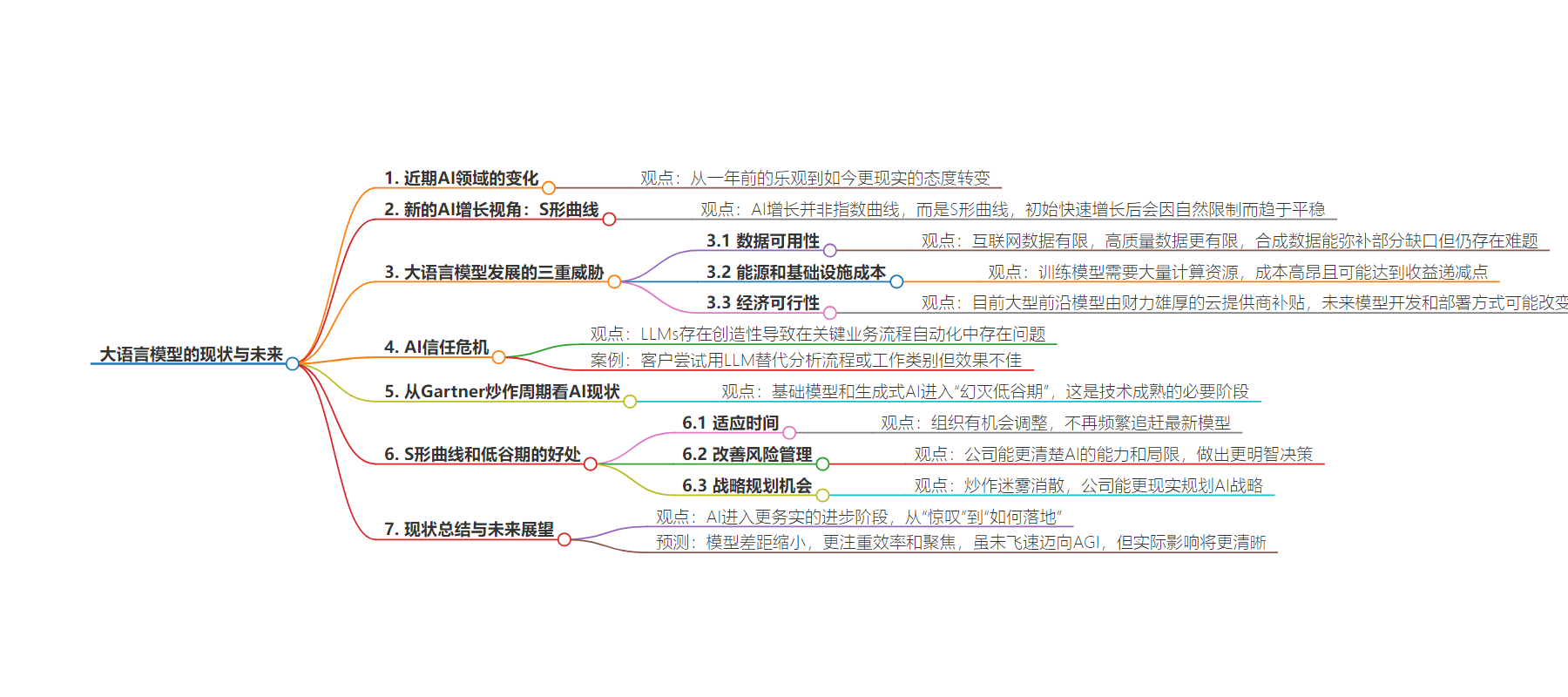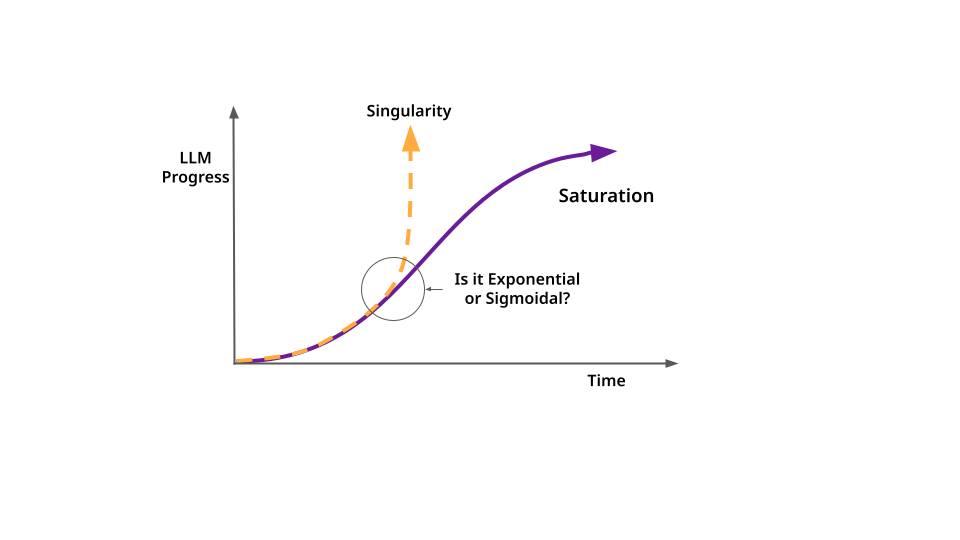包阅导读总结
1. 关键词:LLMs、Sigmoid 曲线、AI 发展、限制因素、未来展望
2. 总结:本文探讨了当前大语言模型(LLMs)的发展状况,指出从乐观转向现实,介绍了 AI 增长的 S 形曲线模型,分析了数据、能源、经济等限制因素及信任危机,认为目前处于低谷阶段,但也有适应、风险管理、战略规划等好处,未来将有整合、聚焦高效模型等趋势。
3. 主要内容:
– 现状与转变
– 从对 AI 的乐观到现实
– 作者参会的感受
– S 形曲线与 AI 增长
– 从指数增长到 S 形曲线
– 因限制因素导致增长变化
– 限制因素
– 数据有限
– 能源和基础设施成本高
– 经济可行性问题
– AI 信任危机
– 模型创造性在关键业务中的问题
– 实例与不足
– Gartner 炒作周期中的位置
– 进入“低谷期”
– 此阶段的意义
– S 形曲线的好处
– 适应时间
– 改进风险管理
– 战略规划机会
– 现状与未来
– 当前不同 AI 技术的阶段
– 未来的整合与模型转变
– 实际创新与影响
思维导图:
文章地址:https://thenewstack.io/the-current-state-of-llms-riding-the-sigmoid-curve/
文章来源:thenewstack.io
作者:Patrick McFadin
发布时间:2024/8/5 14:18
语言:英文
总字数:1336字
预计阅读时间:6分钟
评分:90分
标签:AI 发展趋势,大语言模型,人工智能信任问题,Gartner 技术成熟度曲线,人工智能实际应用
以下为原文内容
本内容来源于用户推荐转载,旨在分享知识与观点,如有侵权请联系删除 联系邮箱 media@ilingban.com
You might have noticed a shift in the air if you’ve been following the AI space lately. The unbridled optimism of a year ago has given way to a more somber, realistic outlook. As someone who spends most weekends knee-deep in AI code and has contributed to projects like LangChain and LlamaIndex, I’ve had a front-row seat to this transformation.
Recently, I attended two AI conferences — the AI Quality Conference and AI Engineer World’s Fair — and the change in sentiment was palpable. It felt like a significant milestone in the AI journey, and I want to share my thoughts on where we are and where we’re headed.
The Sigmoid Curve: A New Perspective on AI Growth
Remember when we thought AI growth was on an exponential curve, ready to leave us all in the dust? Well, reality had other plans. The AI community is now embracing a different model: the sigmoid curve. This S-shaped curve suggests that after an initial period of rapid growth, progress starts to level off as we hit natural limitations.

Why the shift in perspective? It comes down to the constraints we’re facing in large language model development.
The Triple Threat: Data, Energy and Economics
First up is data availability. As massive as the internet is, there’s still a finite amount of high-quality data. Sure, companies like OpenAI are scrambling to make deals for more data to feed GPT-5, but what happens when we need 10x more for GPT-6? Synthetic data will help make up some of the gaps, but this is a hard reality to solve.
Then there’s the energy and infrastructure costs. Training these behemoth models requires an eye-watering amount of computational power. We’re talking racks upon racks of GPUs chugging away, generating enough heat to warm a small town. It’s not just expensive; it’s reaching the point of diminishing returns. In some cases, resource availability limits what’s even possible. The new xAI data center in Memphis, Tennessee, needs a staggering 1 million gallons of water a day and 150 megawatts of power. Researchers and startups are looking to eliminate the GPU requirement, but it is still early days.
Last, there’s the economic viability question. Right now, large frontier models are being subsidized by deep-pocketed cloud providers. But as the true cost of LLMs becomes apparent, we might see a shift in the way these models are developed and deployed. Training a frontier model is a billion-dollar club and requires Nvidia CEO Jensen Huang’s personal cell number.
The AI Trust Crisis
As if these constraints weren’t enough, we’re also facing what’s called the “AI trust crisis.” This was a hot topic at the AI engineering conference. The problem? By design, LLMs tend to get … creative. This is great for writing the next great American novel but not for automating critical business processes. The disconnect is magical thinking about AI and a lack of understanding of the implementation. LLMs are a probabilistic model; they get lost in some cases.
I’ve seen this firsthand with some of our customers: trying to replace analytic processes by feeding large volumes of data into an LLM, or worse, trying to replace an entire job category by letting the LLM do the work unmonitored. Of course, neither of those ideas ended well, leaving the originators upset and with a negative opinion about the capabilities of new AI. Even the insiders realized that the transformer architecture isn’t enough, and we’re settling in at GPT4-level performance across all models. We’re one or two more breakthroughs away from trusted automation or everyone’s favorite buzzword, AGI (artificial general intelligence).
Entering the Trough: Evidence From the Gartner Hype Cycle
If you’re wondering where we are in this AI roller coaster, look no further than the Gartner Hype Cycle. This trusty tool gives us a visual representation of technology maturity and adoption. I can’t embed the graph for the Gartner AI Hype Cycle due to licensing reasons, but I can link you to the presentation that the Gartner folks did with plenty of graphics. It’s worth a few minutes of watching to see how your favorite new technologies stack up.
According to what Gartner is saying in the Hype Cycle for AI, foundation models and generative AI are headed into the “Trough of Disillusionment.” Don’t let the name fool you — this isn’t a bad thing. It’s a necessary step in the maturation of any technology. The early adopters get everyone excited, and power users find many of the early benefits. Late adopters start comparing more mature technology and find the sharp edges, declaring it “all hype” (I’m looking at you, enterprises). Eventually, there are things like support contracts, architecture diagrams and a host of products that make it all much more reliable and safe. Ahh, the dawn of enlightenment.
The Sigmoid’s Silver Lining
Now, before you start thinking it’s all doom and gloom, let me assure you that this sigmoid curve and the “Trough of Disillusionment” have some serious benefits. If you are ready to trust the process, here are some things to feel good about.
- Time for adaptation — As the pace of change slows down, organizations have a chance to catch their breath and figure out how to use these tools effectively. No more constant scrambling to keep up with the latest model that renders last week’s work obsolete. This is what keeps you from getting stuck in an endless POC and finally shipping something.
- Improved risk management — By clearly understanding AI’s capabilities and limitations, companies can make more informed decisions about where and how to implement these technologies. What even a little AI can do to your product and end-user productivity is amazing.
- Strategic planning opportunities — As the fog of hype clears, the path forward becomes easier to see. Companies can start planning their AI strategies with a more realistic view of future capabilities. Not too long ago, there was some crazy speculation about firing entire software engineering teams or all of marketing. AI will do it all, right? Now, it’s clearer that AI is a new skill set in those professions that increases productivity and adds new capabilities. Plan accordingly.
The Current State of Play: From ‘Wow’ to ‘How’
So where does this leave us? If we look at the Gartner Hype Cycle, we see that while foundation models and GenAI are heading into the trough, other AI technologies are at different stages. Knowledge graphs, for instance, are finally pulling out of the trough, likely boosted by their usefulness in AI applications.
The key takeaway? AI isn’t going away, but it’s entering a phase of more measured, realistic progress. We’re moving from the “wow” phase to the “how” phase: How do we actually implement these technologies in a way that adds real value? My advice after absorbing our current state: Relax and get comfortable with what we have today. If you’re building a chatbot, you should be increasing your user’s productivity in some way. Otherwise, you’re just conducting more AI research.
Looking Ahead
What can we expect as we ride this sigmoid curve? I believe we’re in for a period of consolidation and refinement. The gap between models is shrinking, with many leveling off at around GPT-4-level quality. This is great news for power users, who can now build on a more stable foundation.
We’re also likely to see a shift toward more focused, efficient models. The era of “bigger is always better” is coming to an end, replaced by a more nuanced approach that balances capability with efficiency.
While we may not be racing toward AGI at breakneck speed, we’re entering a phase that could be even more exciting. It’s a time of practical innovation, where the real-world impact of AI will start to become clear. So buckle up, fellow AI enthusiasts. The ride might be smoother than expected, but it’s far from over.
YOUTUBE.COM/THENEWSTACK
Tech moves fast, don’t miss an episode. Subscribe to our YouTubechannel to stream all our podcasts, interviews, demos, and more.
